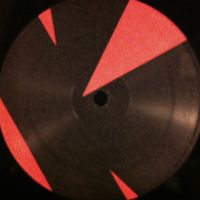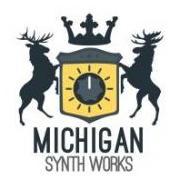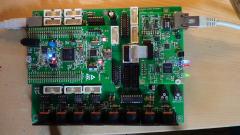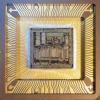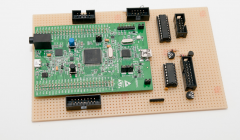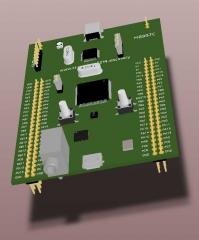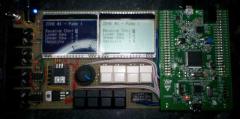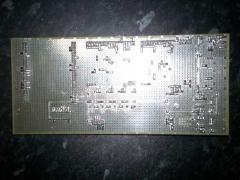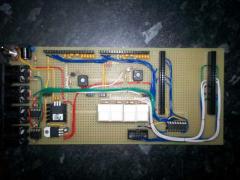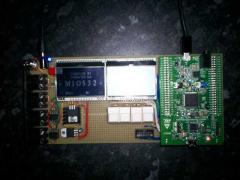Search the Community
Showing results for 'STM32F4'.
-
Hello, I got my STM32F4 board today, and for reasons beyond my understanding I cannot get any LEDs other than LED1 to light up. I am modifying the application template - so my code is as minimalistic as it gets. If I call MIOS32_BOARD_LED_Set(1,1), the green LED turns on. MIOS32_BOARD_LED_Set(2,1) or even MIOS32_BOARD_LED_Set(0xF, 1) do nothing. Some answers to potentially obvious questions: 1) I am certain I am properly recompiling the code and uploading, as I see the green led no longer lighting up when trying MIOS32_BOARD_LED_Set(2, 1) and lighting up again when I switch to MIOS32_BOARD_LED_Set(0xF, 1). 2) I tried commenting out the code in the timer function and simply turning the LEDs on in APP_Init() 3) I am compiling using the following env variables: export PATH=$PATH:/Users/eran/Projects/mutebox/gcc-arm-none-eabi-4_7-2013q3/bin export MIOS32_PATH=/Users/eran/Projects/mutebox/mios32-svn export MIOS32_BIN_PATH=$MIOS_PATH/bin export MIOS32_GCC_PREFIX=arm-none-eabi export MIOS32_FAMILY=STM32F4xx export MIOS32_PROCESSOR=STM32F407VG export MIOS32_BOARD=MBHP_CORE_STM32F4 export MIOS32_LCD=universal What am I missing? Thanks!
-
Hi everyone, I have a strange problem with my STM32F4 Discovery not being able to communicate with MIOS studio. I flash the STM32F4 with the mios32 bootloader no issues via ST link, but then if I reboot the core and connect through the left Micro-USB, the USB MIDI driver doesn't come up on either windows or macOS (so I can't connect it to MIOS studio). If I boot the core in boot hold mode, the USB-MIDI driver comes up on both Mavericks or Win7 (MIOS bootloader) the core gets recognised and can upload an application (ID=0), but when I then upload midibox_seq_v4_086 and reboot, even though it works on the displays of my MbSeq4, no USB Midi drivers again in either Win7 or Mavericks. To test further, through boot hold mode I uploaded midio128_v3_019, reboot, and the drivers do come up and I can use the terminal, but I get 'No response from MIOS8 or MIOS32 core' (I've checked with all Device ID values, none works). If I now try to upload midibox_seq_v4_086 I get the 'Warning: no reponse from the core' message half way through and the core doesn't seem to send an upload request after booting. I have done this when the STM32f4 Discovery board is not connected with the MBHP_CORE_STM32F4 module and it exhibits the same behaviour. Is this midibox_seq_v4_086 messing up the USB midi drivers somehow? Or perhaps some residual code somewhere if it connects under boot hold? Any help is much appreciated!
- 20 replies
-
Hallo zusammen, ich stehe mal wieder auf dem Schlauch. Möchte gerne meinen DIY-Tube-Preamp midifizieren. In einem ersten Schritt soll für einen Prototypen der Volume-Poti verschwinden und eine Lautstärkeregelung über das PGA2311 erfolgen. Es hapert im Moment an der Verdrahtung von diesem IC mit dem STM32F4. Hat jemand einen Schaltplan hierfür?? Mwpost
-
So reading through the documentation, I find this statement: "..but as long as only OSC messages should be sent and received, the external MBHP_ETH module might be sufficient..." I'm thinking about laying out a combo ETH/USB module for the core and am a little concerned about the "might" part of that. Is this something that is not tested at all and should work in theory or not tested at all and who knows if it will work?
-
I have used the software provided by ST to input the bootloader into the Discovery Unit when plugged into the PCB. I have a very small number of components on the PCB . (Namely IC1 and IC2 and their capacitors and the R33 resistor network) The problem I found was that the ST Link software would not recognise the bootloader hex file. I messed around a bit and the tried the exercise again this time using the Discovery unit on its own. The hex file was recognised and the bootloader apparently loaded. Is this normal? I am wondering whether there is a problem due to there being no power on the IC's. Maybe someone can explain. Regards Robin
-
Gibt es irgendwo ein Layout zum Selberätzen/Lochraster? Danke; Grüße aus Kiel
-
Having given up on using Windows 7 with MIOS STUDIO I have switched to a PC running LINUX (Mint). MIOS STUDIO seems to work properly. I have managed to download hex files using MIOS STUDIO, it would seem. However I would like proceed slowly and looked for an application that I could use to check that the STM32F4 core is OK. Tutorial 5 seemed to be the ideal candidate as it only needs shorting links to be applied to J5 connector. I am not sure whether this APP is ready for STM32F4. I get no response Please let me know if this is the case and if not let me know if there is another application that would be suitable. Or, whether I am likely to have a fault on the hardware. Thanks Robin
-
Hi all, i was a little bit surprised when my new STM32F4 board arrived because i ordered this one: Link But i received this Version Now the big question: Is it compatible? If needed it would be no problem to change the core board wiring. Best regards Marxon
-
Hi all! While working on my Midibox NG, I was careless for a moment and powered the STM32F4 core with too high voltage. :cry: Now it seems that something is faulty on the STM Discovery board because there is a short circuit between the GND and 5V pins (4 ohms). My first thought was to check diode D1, D2 and D3, but they are OK. Now i guess U1 or U3 might be have been destroyed but before i start to desolder them, i first want to ask if somebody might better know what to check . Thanks a lot for your help! :thumbsup: Best regards Marxon
-
Hello guys, I am facing a stupid problem with a LCD (4x20) connected to the RTP-MIDI core... It simply does not start. I am sure that I forgot something somewhere, but I can't find what I have verified all lines under the bootloader using the testlcdpin command, everything is fine I have set the display size to 4 x 20 in the bootloader In my app, in the APP_Background, I have put this sequence : MIOS32_LCD_Init(0); MIOS32_LCD_Clear(); while (1) { MIOS32_LCD_CursorSet (0,0); MIOS32_LCD_PrintFormattedString ("TEST"); } but my display clearly does not even initialize (I see the "default" squares when I set the contrast to the max). Moreover, I was expecting activity on pins PA8, PD3 and PD6... but nothing at all (checked with my oscilloscope), like if the LCD driver did not start at all. What did I miss ?
-
Is it possible, as an alternative to STM32F4DISCOVERY board, to use the better STM32F429IDISCO, offered with an integrated LCD and more I / O? Regards Karl
-
From the album: RTPMIDI_CORE_STM32
Picture of the first assembled RTP-MIDI CORE STM32F4 board, equipped with the RTP-MIDI OEM module, and doing the first test run.© BEB
-
I noticed that a port to the STM32F4 Discovery has shown up in the MIOS sources. What is the status of the port? Is a new Core board planned? The STM32F4 parts have a few features that the LPC1769 doesn't, mainly a proper SD card controller that can use 1 or 4 bit modes instead of SPI, should be a lot faster; and an external memory controller for SRAM or additional Flash. Unfortunately the 100 pin part on the Discovery board doesn't expose all the pins needed to properly interface with external memories, but for synth/sampler-types of instruments the prospects of a MIOS with access to megabytes of fast storage is quite exciting I think :smile: The Discovery board does have the nice feature of an integrated audio quality stereo DAC, which I'd hope to see supported.
-
I can't find a jumper on the STM32F4 core board for the bootloader hold mode - what is the easiest way to get my core board back to life after it crashes with a hard fault during init? Thanks, ilmenator
-
-
Hi, just to let all the KiCAD users know there is a very nice library / footprint with accompanying 3D model for the STM32F4 discovery board (and lots of other good stuff) out there from Walter Lain. Go check his homepage! Best, ilmenator
-
Hi all! I like to control my Seq V4 (LPC1769) with my MidiboxNG (STM32F4) via Midi. Is it correct if i connect LPC1769 Core P2.1 to STM32F4 Core PA2 and LPC1769 Core P2.0 to STM32F4 Core PA3? Thanks for your advice. Marxon
-
Hi everybody! I'm thinking about building a hybrid synth with the new STM32F4 core. With hybrid, I mean something like the Mutable Instruments Ambika: Digital Oscillators and modulators (envelopes, lfos) but analog filters. I'm thinking about an 8-voice synthesizer with 3 envelopes, 3 lfos, 3 oscillators + noise per voice. Now I'm wondering how powerfull the new STM32F4 core really is. If I wanted to run a total of 24 wavetable-oscillators, 24 envelopes, 24 lfos, and additional things like ringmodulators, noise, ... on it with a samplerate of at least 44.1kHz, would it manage the load? As a comparison: The Ambika uses a separate ATmega@20MHz for each voice. Its signal processing is lofi with mostly 8bits resolution, but some stuff is done at 12 or 16bit. A voice on the Ambika has 2 oscillators, 2 envelopes, 2 lfos and runs at 39kHz (if I read it right). So if I take that as a guide and scale it up - I would need at least 160MHz to run 8 voices in parallel. The DMA of the STM32 makes transferring data a bit lighter and the 32bit architecture makes calculations with 16bits an easy thing. So it could even fit a third oscillator per voice... I know, the comparism to the 8bit ATMega is rubbish. But at least it could give an idea of the workload that comes with such a synthesizer design. I find it really hard to even estimate the power of the STM32F4. what do you think?
-
Hi - I was about to order parts to put together an MBSeqv4 when I noticed that there is a core stm32f4 module available. Is this now the preferred core to use with seqv4 or is it still the LPC17 (which seems more expensive, and seems to now feature a mismatched pin config...)? I've looked through Ucapps and this forum and was left feeling unsure.
-
I have a MBCV V2, and a NG I use W7 When connecting them to my computer, they both come up in the Device Manager as MIDIbox CV and MIDIbox NG but in Send SX and Ableton Live, only one come up I have used the Bootloader Update app. to "set single_usb 1" and "set device_id" Still it's not working Any suggestions?
-
I have upgraded my MB64 for my AY-synth to NG on a STM32F4 to take advantage of the "Radio buttons" DINx2 (15 buttons) DOUTx2 (15 LED's) 2 pots Q: Is it possible to connect the 2 pots directly to the STM32F4? Q: Are the MIDI notes coming in through USB, merged with the CC messages from the buttons and output to MIDI1 OUT on PA2? Best regards Halvor
-
-
-
Hi, Been a MIDIbox user for a few years now (thanks, TK!) but this is the first time I've not found my question already answered somewhere. Having been on MIOS8 for so long, I recently got an STM32F4 Discovery to start work on replacing my existing board. It was all going really well until I tried add an RTOS task with (I presume) not enough stack memory allocated, resulting in a "hard fault at PC=0x00000000". I've amended my code to allocate a bigger stack, but now I seem to have no way to upload any more. The error condition occurs very soon after bootup (in App_Init()), but using the reset button on the Discovery board doesn't seem to trigger an upload request - MIOS Studio doesn't respond in any case. I'm guessing my config must have fastboot turned on. I found a mention of the "BSL Hold" jumper here http://www.ucapps.de/mios32_bootstrap_newbies.html, but that seems to be for the LPC17 board only. Is there any equivalent on the Discovery?? Hoping someone can help! Regards, - Paul

